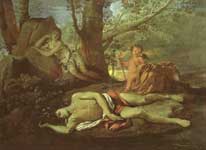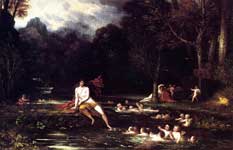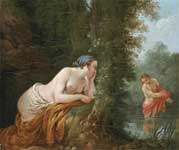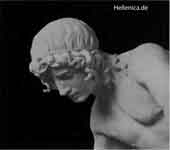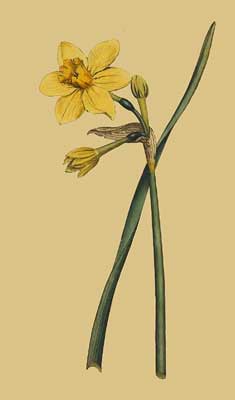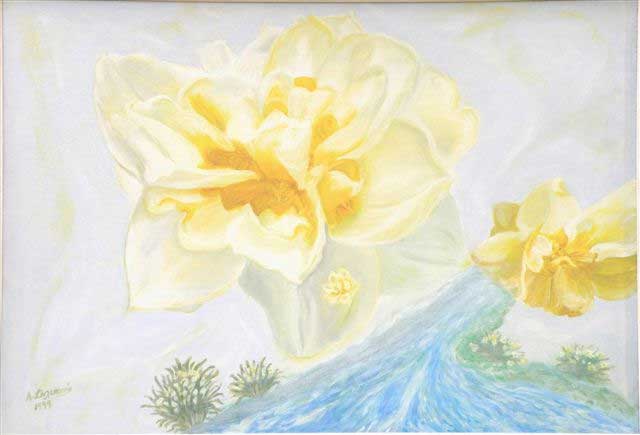.

Narcissus fresco from Pompeii
In Greek mythology, Narcissus or Narkissos (Greek Νάρκισσος), was a hero of the territory of Thespiae in Boeotia who was renowned for his beauty and his pride. Several versions of his myth have survived: Ovid's, from his Metamorphoses; Pausanias', from his Guide to Greece, (9.31.7); and one found among the Oxyrhynchus papyri.
Pausanias locates the spring of Narcissus at Donacon 'Reed-bed' in the territory of the Thespians. Pausanias finds it incredible that someone could not distinguish a reflection from a real person, and cites a less known variant in which Narcissus had a twin sister. Both dressed the same and wore the same kind of clothes and hunted together. Narcissus fell in love with her. When she died, Narcissus pined after her and pretended that the reflection he saw in the water was his sister.
As Pausanias also notes, yet another tale is that the narcissus flower was created to entice Demeter's daughter Core away from her companions to enable Hades to abduct her.
Ovid's version
In Metamorphoses, Ovid tells the story of a graceful and pretty nymph named Echo who loved Narcissus in vain. Narcissus' beauty was so unmatched that he felt it was godlike in scope, comparable to the beauty of Bacchus and Apollo. As a result, Narcissus spurned Echo's affections until, despairing, she faded away to nothing but a faint, plaintive whisper. To teach the vain boy a lesson, the goddess Nemesis doomed Narcissus to fall in love with his own reflection in Echo's pond. Entranced by his own beauty and enamoured with his own image, Narcissus lay on the bank of the river and wasted away staring down into the water. Different versions of the story state that Narcissus, after scorning his male suitors, then was cursed by the gods to love the first male that he should lay his eyes on. While walking in the gardens of Echo he discovered the pond of Echo and saw a reflection of himself in the water. Falling deeply in love with himself, he leaned closer and closer to his reflection in the water, eventually falling into the pond and drowning.
Archaic version
This, a more archaic version than the one related by Ovid in his Metamorphoses, is a moral tale in which the proud and unfeeling Narcissus is punished by the gods for having spurned all his male suitors. It is thought to have been meant as a cautionary tale addressed to adolescent boys. Until recently, the only source for this version was a segment in Pausanias (9.31.7), about 150 years after Ovid. However, a very similar account was discovered among the Oxyrhynchus papyri in 2004, an account that predates Ovid's version by at least fifty years.
In this story, Ameinias, a young man, loved Narcissus but was scorned. To tell Ameinias off, Narcissus gave him a sword as a present. Ameinias used the sword to kill himself on Narcissus' doorstep and prayed to Nemesis that Narcissus would one day know the pain of unrequited love. This curse was fulfilled when Narcissus became entranced by his reflection in the pool and tried to seduce the beautiful boy, not realizing it was himself he was looking at. Completing the symmetry of the tale, Narcissus takes his sword and kills himself from sorrow.
Narcissism
Narcissism is named after Narcissus, and both derive from the Greek word narke "numb" from which we also get the word narcotic. Thus for the Greeks Narcissus stood for vanity, callousness and insensitivity, as he was emotionally numb to the entreaties of those who fell in love with his beauty.
The narcissus flower
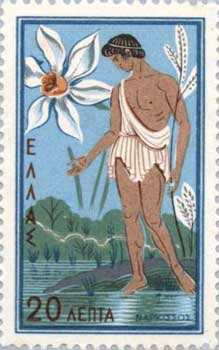
Greek Stamp of Narcissus and the Narcissus flower
The Narcissus flower blooms early in the spring and is often found in damp soil near to a pond. It is a self-sufficient, fertile but stagnant environment. The flower is usually of six white vesica-shaped radiating petals with a central yellow funnel containing the stamen and the stigma. The stem bends just before the blossom, tilting it so the blossom faces out or down rather than up. According to myth, this is because Narcissus was gazing down at his reflection when he was transformed into the flower. The stalk is otherwise firm and upright. In Islam the Hadith of Bukhari associates the flower with the upright and righteous man. The symbol has also been likened to the transformation of vanity and self-centeredness into the humility of a more individuated and spiritual self.
Bibliography of reconstruction: Ovid, Metamorphoses III.340 - 350, 415 - 510 (8 AD); Pausanias, Description of Greece 9.31.7 (143 - 176 AD)
The myth's influences
The parable of Narcissus has been a rich vein for artists to mine for at least two thousand years, beginning with the Roman poet Ovid (book III of Metamorphoses). This was followed in more recent centuries by other poets (Keats), and painters (Caravaggio, Poussin, Turner, Dalí, and Waterhouse). In Stendhal's novel Le Rouge et le Noir (1830), there is a classic narcissist in the character of Mathilde. Says Prince Korasoff to Julien Sorel, the protagonist, with respect to his beloved:
She looks at herself instead of looking at you, and so doesn't know you. During the two or three little outbursts of passion she has allowed herself in your favor, she has, by a great effort of imagination, seen in you the hero of her dreams, and not yourself as you really are. (Page 401, 1953 Penguin Edition, trans. Margaret R.B. Shaw).
The myth had a decided influence on English Victorian homoerotic culture, via the influence of Andre Gide's study of the myth Traite du Narcisse ('The Treatise of the Narcissus', 1891), and the influence of Oscar Wilde. Also, many characters in Fyodor Dostoevsky's (19th-Century Russian Writer) writings are lonely Narcissus-types, such as Yakov Petrovich Golyadkin in "The Double" (Published 1846).
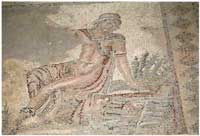
Paintings
Narcissus, 1881, Gyula Benczúr (1844– - 1920)

Liriope Bringing Narcissus before Tiresias, Giulio Caprioni, Tiresias prophesy was that a long life for Narcissus as long as he did not "come to know himself"
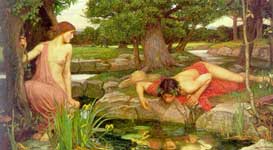
Echo and Narcissus (1903), J. W. Waterhouse
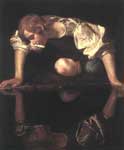
Derived word: Narcotic
Further reading
Louise Vinge. (1967). The Narcissus Theme in Western Literature up to the Nineteenth Century. (The classic in-depth study).
See also : Greek Mythology. Paintings, Drawings
| Ancient Greece
Science, Technology , Medicine , Warfare, , Biographies , Life , Cities/Places/Maps , Arts , Literature , Philosophy ,Olympics, Mythology , History , Images Medieval Greece / Byzantine Empire Science, Technology, Arts, , Warfare , Literature, Biographies, Icons, History Modern Greece Cities, Islands, Regions, Fauna/Flora ,Biographies , History , Warfare, Science/Technology, Literature, Music , Arts , Film/Actors , Sport , Fashion --- |
Retrieved from "http://en.wikipedia.org"
All text is available under the terms of the GNU Free Documentation License


